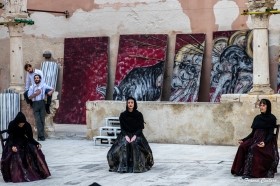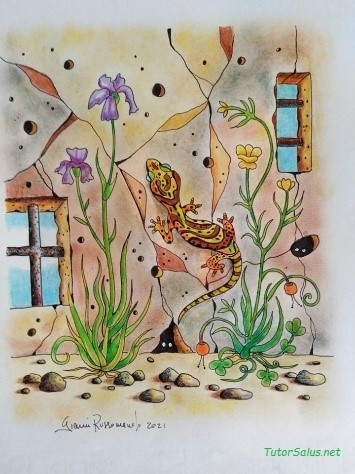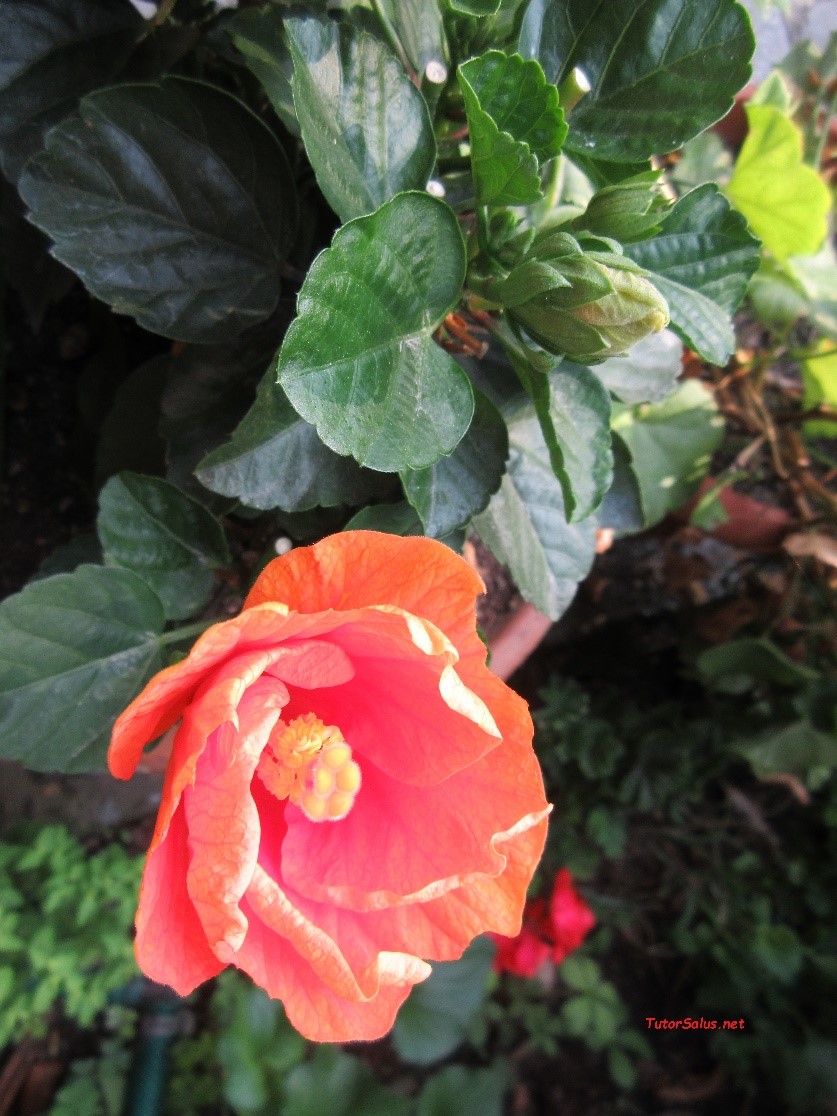Toward an Academy of excellence.

Photo by Franca Centaro.
As far as the best performance of ‘Pilade’, ending essay for students of III year at the ‘Accademia d’Arte del Dramma Antico’[2] in Siracusa, we wonder about a capability both in studying and in professionalism caring, here linked with theater, which can so much attract young people : bringing on stage this nice work[3] - written by Pier Paolo Pasolini and maybe following ‘Orestea’ by Aeschilous as Pasolini imagines a joyful coming back of Oreste, the successor prince to king Agamemnon in Argo after the verdict of not guilty, favoured by Athena – the young actors and actresses have excellently three-year period in Academy focused on Greek Theater, and anticipating also their good debut at the Ancient Theater of Siracusa during the annual performance of classical works, side by side to professional actors and actresses.
Salvatore Salvo Bitonti is teacher at the Academy in ‘acting’, and director of ‘Pilade’[4], carried out with the students in the standard four weeks : but here, the ‘first’ has been preceded by a punctual work of rewriting by students, not only to reduce the original long text but also to get an affordable translation, other than communicative enough about a more up-to-dateness of characters.
“The art of direction is really complex, and was born in twentieth century” – says Salvo Bitonti, who already has been theatrical director for almost forty years and of more than thirtyfive works with famous Italian actors.
Only at the beginning of last century, from ‘Moscow Art Theater’ a professionality of the director could emerge, as till then it was confused with the author himself or with the leading actor : in the Greek Theater the rituality was essential and depending on fixed canons of which the author himself was responsible to the public,
Konstantin S. Stanislavskij (1863-1938), who in 1898 founded in Moscow a ‘Theater of Art’, lastly experienced acting on his own, by an assiduous study and also working with the dramatist Vladimir Nemirovic-Dancenko (1858-1943), up to gather a theatrical pedagogy available both for actors and directors.
“Direction begins when choicing a text and how interpreting it, then directing any necessary elements – firstly the actors – but also the lights, the sounds…”
And, about sound, it has here a creative role, and the Chorus – central and essential in the Greek Theater for its position on the stage – here is really a leading part for its sorrow suspension anticipating and pointing the text, which is indeed a contemporary text but written as a classical tragedy.
“Nothing can be forgotten : Eumenides lowered remember their fury, and cease, loose themselves…”, the Chorus sadly says when the gods no more can recover confidence as Athena instituted to prevent from wars.
“Pasolini did mean ‘Pilade’ as a revolutionary work and here the Chorus is a revolution” – says Salvo Bitonti – “because there are only feminine voices in this edition, while the original had both masculine and feminine voices together. Pasolini – of whom this year is the first centenary from his birth – has, by me, intended the chorus as specifically feminine.”
We know, on the other hand, how can influence in a song the pronunciation of syllables and their ‘reverberation’, a technical word to describe both the masking and the reinforcement of intensity of the source. Which part has then the voice, its musicality or its screeching, when an actor is training?
“An actor has to know how to get back his memory and up to a ‘revival’” – the word was invented by Konstantin S. Stanisvlaskij, n.d.r.) – answers the director who in the past years worked out a method, by accepting not only the lesson of Stanisvlaskij but also that one of Bertolt Brecht[5].
It is remarkable that, both the ‘revival’ of Stanislavskij and the ‘estrangement’ of Brecht have to be specifically produced in an actor : with Stanislavskij, for example, by making around the actor that triggering condition near to neonatal synaesthesia where sound and visual seem intertwined, and the perception is far from what usually felt by the person. On the other hand, a ‘representation’ as Freud[6] described it is really an actvity the unconsciousness does to evaluate, accepting or rejecting what he, or she meets : in the traditional analytical work a ‘representation’ then, cannot be in any way induced.
“I preferred that our work could be shared among actors and actresses, all young and enthusiastic, also for an essential critical awareness not only of interpretation of the text, quite difficult as ‘Pilade’ by Pasolini, but also emotional for each one of them…”
Oreste e Pilade fight one against the other from the beginning on the stage, however they love each other : Pilade, hidden by Aeschilous here is standing up and speaks in this Pasolini work. Both of them areheroes, and society does call for them : the pragmatic ones prefer Oreste, but the intellectual ones follow Pilade.
Electra is the ‘commandable’ woman, she was instigating Oreste to murder their mother Clitemnestra and now however she is venerating the dead one as a real ‘queen’. “In our enemies we find unknown lovers…”, Electra to Pilade suddenly admits. And then Athena, the god, is coming out from maskers, as motionless monuments looking around at the stage, and is approaching to Pilade.
“I’m no more than a god for humans – says Athena – rather than an idea…” and the not visible prison where the work goes on[7] , finally seems evident, as what has been just kept silent will again sadly blow on thinking and on human stories : when you bow to gods, you lack meeting any real appointment in your life.
More than excellet then, it seemed to me that unspeakable uncertainty – at last also nominated by Pilade, and the bitternessof Pasolini cold even imagine – to which the endi of this good work does stop, as finishing this III year of the ‘Accademia del Dramma Antico’, suddenly opening to those better projects which our mind can also think, then.
Marina Bilotta Membretti, Cernusco sul Naviglio October 8 2021
[1] Salvatore Salvo Bitonti, theatrical teacher director and essayist, was born in Siracusa (1961) and has been principal (2013-2019) of the ‘Accademia Albertina di Belle Arti’ in Turin, so raising enough the fame of the school in that period also abroad, and in the same time focusing the attention of our Government two unsolved items : our Italian Art Academies degree as an international title too, and the equalization to universitary title of the academic one which limits also the access to public funds. Salvo Bitonti is still chair holder of ‘Direction and Movie History’ at the ‘Accademia Albertina’ di Torino. Amog other works he directed : ‘Andromaca’ by J.Racine (1985, Mario Luzi’ translat.), ‘Hystrio’ by M.Luzi (1987) with Paola Borboni, ‘L’acqua e i sogni’ from G.Bachelard (1994) with Franca Nuti and Giancarlo Dettori, ‘L’isola della dottoressa Moreau’ by U. Ronfani with Ugo Pagliai and Paola Gassmann, ‘Fedra’ by G. Ritsos (1999-2000) with Mita Medici, ‘Alcesti’ by Marguerite Yourcenaur (2008) with Franco Nero and Mita Medici, other than the direction of a number of ending theatrical essays of students, also for example at ‘Cinecittà Campus’ in Rome. In 2008 he is appointed as art director of ‘Sicilian Film Festival’ in Miami (U.S.A). He is also author of the essay ‘Dioniso & Pirandello : lo spettacolo nel Novecento tra mito e utopia’ (1999, Roma Ed. ‘Marianna’). Now he is coordinator of ‘Art and Education’ Section for the ‘European Expo Dubai’.
[2] ‘Accademia d’Arte del Dramma Antico’ is one of the most important activities of the Fondazione I.N.D.A. Istituto Nazionale del Dramma Antico and its place in the ex Convento of San Francesco, at Ortigia in Siracusa, Via Tommaso Gargallo 67 : it was established with farsightedness by Giusto Monaco (1915-1994, teacher of Latin and Greek language, president of I.N.D.A. 1993-1994) and by Fernando Balestra (1952-2016, director and dramatist, I.N.D.A. superintendent 2005-2012).
[3] ‘Pilade’ was written by Pier Paolo Pasolini in 1966 but put on stage the first time at the Greek Theater in Taormina only in 1969 : it is a tragedy (Pilade will have to leave Argo in exile) in nine episodes, so that is very very long. Pasolini had already quickly translated from ancient Greek the ‘Orestea’ by Aeschilous, on suggestion of Vittorio Gassmann in order to put it on the stage at Siracusa Theater in 1961, but it was not accepted. In ‘Pilade’, infact Pasolini does unmask the solution of Aeschilous in ‘Eumenidi’ as they can be easily lead again to the fury of ‘Erinni’.
[4] ‘Pilade’, ending essay 2021 of the III year students of the ‘Accademia d’Arte del Dramma Antico’ was put on the stage last March 2021 at ‘closed doors’ in the courtyard of the Academy in Siracusa and respectfully toward anti Covid19 new rules : however there have been more than 3.500 visualizations on Facebook and Youtube. Twelve are the admitted interpreters : Virginia Bianco, Spyros Chamilos, Serena Chiavetta, Federica Cinque, Rosario D’Aniello, Simona De Sarno, Manfredi Gimigliano, Giorgia Greco, Alessandro Mannini, Ornella Matranga, Francesca Piccolo e Gaia Viscuso. Also teachers cooperated to the performance : Simonetta Cartia for the best chorus, Alessandra Fazzino for the phisical writing and gestures, Elena Polic Greco for the voice technic and diction. In addition, Dario Arcidiacono for music, the scene designer Tony Fanciullo for the hand-painted panel, the masks and furniture on the stage, inspired - as the wonderful stage costumes from Laboratory of I.N.D.A. - to the ‘poor art’ of the artist Jannis Kounellis who was contemporary to Pasolini. The photographic documentation on Youtube video and Facebook has been edited by Nanni Ragusa and Nanni Musiqo.
[5] Bertolt Brecht (1898-1956) was born at Augusta in Germany and was educated according to Protestant religion as his mother : dramatist, essayist, director he didn’t accept the nationalism as it was spreading in Germany and soon he was included in the ‘black list’ of Hitler (1923). He joined to deutsch expressionism, which was subjectivist and disenchanted. After Hitler went to Government, he had to leave Berlin where he was living and working (1933) to a long and laborious exile together with his wife and children : in 1941 he went to U.S.A. from which then he came out, with an imputation of anti-american activist. From 1948 he lived in Berlino, but without openly joining to Communist policy in those years, also if secretly he supported its ‘realist art’. Notwithstanding his silent and nonconformist nature he got to have longlasting relations, both professional and affective : his method for theater, which is nowadays as a school method, was based, differently from Stanisvlaskij, on the capability to ‘distance’ (verfremdungseffekt ) the actor from his character, so that stimulating an analytical criticism.
[6] Cfr ‘Scritti metapsicologici’, S.Freud (1915) in Bibliot. Bollati Boringhieri.
[7] The courtyard of the Academy in Siracusa can be a starting point for a ritual circle stage on which water air fire and earth are the essential items in Nature : beyond the arches of the cloister you can see the panel handmade by the scene designer Tony Fanciullo, as a ‘decollage’ by the artist Mimmo Rotella (1918-2006) and the famous Sixties to when this work by Pasolini refers.





